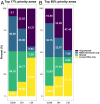High exposure of global tree diversity to human pressure
- PMID: 35709320
- PMCID: PMC9231180
- DOI: 10.1073/pnas.2026733119
High exposure of global tree diversity to human pressure
Abstract
Safeguarding Earth's tree diversity is a conservation priority due to the importance of trees for biodiversity and ecosystem functions and services such as carbon sequestration. Here, we improve the foundation for effective conservation of global tree diversity by analyzing a recently developed database of tree species covering 46,752 species. We quantify range protection and anthropogenic pressures for each species and develop conservation priorities across taxonomic, phylogenetic, and functional diversity dimensions. We also assess the effectiveness of several influential proposed conservation prioritization frameworks to protect the top 17% and top 50% of tree priority areas. We find that an average of 50.2% of a tree species' range occurs in 110-km grid cells without any protected areas (PAs), with 6,377 small-range tree species fully unprotected, and that 83% of tree species experience nonnegligible human pressure across their range on average. Protecting high-priority areas for the top 17% and 50% priority thresholds would increase the average protected proportion of each tree species' range to 65.5% and 82.6%, respectively, leaving many fewer species (2,151 and 2,010) completely unprotected. The priority areas identified for trees match well to the Global 200 Ecoregions framework, revealing that priority areas for trees would in large part also optimize protection for terrestrial biodiversity overall. Based on range estimates for >46,000 tree species, our findings show that a large proportion of tree species receive limited protection by current PAs and are under substantial human pressure. Improved protection of biodiversity overall would also strongly benefit global tree diversity.
Keywords: biodiversity; conservation frameworks; land use; protected areas; tree species.
Conflict of interest statement
The authors declare no competing interest.
Figures





References
-
- Pan Y., et al. , A large and persistent carbon sink in the world’s forests. Science 333, 988–993 (2011). - PubMed
-
- Bastin J. F., et al. , The global tree restoration potential. Science 365, 76–79 (2019). - PubMed
-
- Brockerhoff E. G., et al. , Forest biodiversity, ecosystem functioning and the provision of ecosystem services. Biodivers. Conserv. 26, 3005–3035 (2017).
-
- Gibson L., et al. , Primary forests are irreplaceable for sustaining tropical biodiversity. Nature 478, 378–381 (2011). - PubMed
Publication types
MeSH terms
LinkOut - more resources
Full Text Sources
Research Materials

